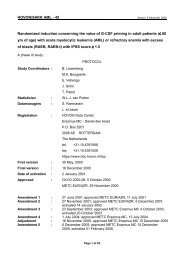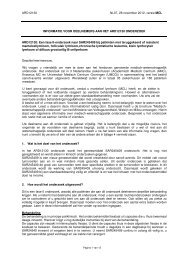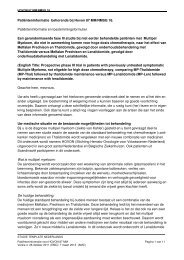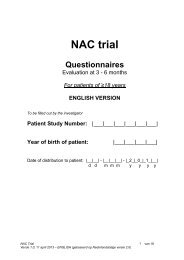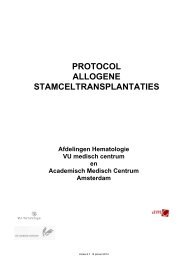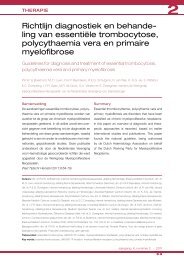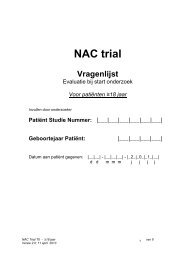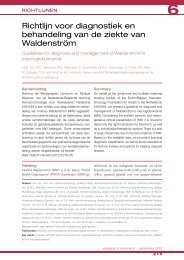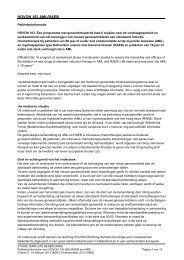A multicenter, randomized phase III study of bortezomib and ...
A multicenter, randomized phase III study of bortezomib and ...
A multicenter, randomized phase III study of bortezomib and ...
Create successful ePaper yourself
Turn your PDF publications into a flip-book with our unique Google optimized e-Paper software.
HOVON 104 AL AMYLOIDOSIS Clinical trial protocol version 7, 27 November 2012<br />
5 Introduction <strong>and</strong> rationale<br />
5.1 AL Amyloidosis <strong>and</strong> current treatment<br />
Disease<br />
AL amyloidosis is caused by a small monoclonal population <strong>of</strong> plasma cells in the bone marrow,<br />
synthesizing monoclonal light chains that undergo conformational modifications <strong>and</strong> aggregate into<br />
amyloid fibrils that form extracellular deposits in one or more vital organs, most frequently the kidney,<br />
heart, liver <strong>and</strong> peripheral <strong>and</strong> autonomic nervous system.<br />
The disease is rare with an estimated incidence <strong>of</strong> 0.8 per 100,000 person years. The median age is<br />
60 years with a male predominance (57%). If untreated, AL amyloidosis is a progressive disease <strong>and</strong><br />
is usually fatal within 2 years. 1<br />
Patients can present with nephrotic syndrome, renal failure, hepatosplenomegaly, congestive heart<br />
failure, arrythmias, postural hypotension, syncope, <strong>and</strong> pseudo-obstruction <strong>of</strong> the gastro-intestinal<br />
tract. Highly suggestive physical findings are macroglossia <strong>and</strong> periorbital purpura. Approximately<br />
70% <strong>of</strong> patients present with 2 or more organs involved.<br />
Diagnosis & Prognosis<br />
The diagnosis <strong>of</strong> AL amyloidosis is based on a clinical suspicion <strong>and</strong> confirmed by a tissue biopsy,<br />
usually <strong>of</strong> an involved organ. The type <strong>of</strong> amyloid must then be determined. Patients with AL<br />
amyloidosis will have a clonal plasma cell dyscrasia.<br />
Since the extent <strong>of</strong> cardiac involvement is the most important determinant <strong>of</strong> clinical outcome, a<br />
staging system to evaluate the cardiac injury has been developed. 2 This system uses the serum<br />
markers N-terminal fragment <strong>of</strong> pro-brain natriuretic peptide (NT-ProBNP) <strong>and</strong> troponin T or I. NT-<br />
ProBNP is produced when there is increased wall stress <strong>of</strong> the heart <strong>and</strong> the cardiac tropinins are<br />
highly specific sensitive markers <strong>of</strong> cardiac injury.<br />
A very helpful tool in the diagnosis <strong>and</strong> response assessment is the serum free light chain (FLC)<br />
immunoassay which consists <strong>of</strong> a polyclonal latex-conjugated anti-free light chain antibody with high<br />
specificity <strong>and</strong> affinity for serum free light chains. This assay has improved the diagnosis <strong>and</strong><br />
monitoring <strong>of</strong> AL Amyloidosis patients. M-proteins can be detected in the serum or urine in only 50%<br />
<strong>of</strong> patients, whereas the FLC assay can detect <strong>and</strong> quantify light chains in about 90% <strong>of</strong> patients.<br />
Many studies have demonstrated that achieving a hematological response is closely related with<br />
survival. This is not only demonstrated after high dose therapy 3;4 but also after st<strong>and</strong>ard dose<br />
therapy. 5;6<br />
The quality <strong>of</strong> hematological response is also very important; patients achieving a complete<br />
hematological remission (CHR) having the best survival <strong>and</strong> therefore hematological response is a<br />
valid endpoint in clinical trials. 7<br />
Page 14 <strong>of</strong> 75 EudraCT-No: 2010-021445-42






